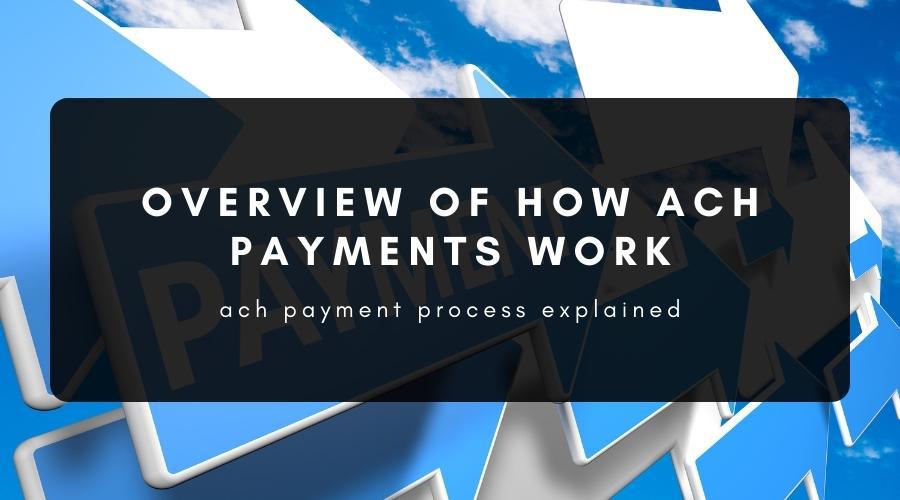
How ACH Payments Work
The automated clearing house (ACH) is the network used for electronic funds transfers (EFT) in the United States and Puerto Rico. This system is governed by NACHA, short for National Automated Clearing House Association. ACH payments are becoming more popular every year thanks to their security, low cost and shorter turnaround times.
What Information Do You Need to Make ACH Payments?
To send (“push”) or charge (“pull”) an ACH payment, all you need is:
- The account holder’s name
- The ABA routing number
- The account number
- The amount of money to be transferred
How an ACH Transaction Works, Step by Step
- The sender fills out the ACH transfer details in their internet banking platform and confirms the transaction.
- When it comes time for the next batch to be processed, the entries are aggregated and sent from the originating depository financial institution (ODFI) to an ACH operator.
- The ACH operator sorts the entries to make sure each transfer goes in the right direction (push or pull).
- The ACH operator sends each entry to the relevant receiving depository financial institution (RDFI).
- The RDFI communicates with the ODFI to make sure there are sufficient funds in the sender’s bank account for the electronic transfer and completes the transaction, minus any transaction fees.
- The transaction is now complete, unless there is a subsequent ACH recall or reversal.
How Long Do ACH Payments Take to Clear?
The quickest an ACH payment would arrive is the same day it was pushed or pulled. The longest it could take is three to five business days, which is long compared to popular emerging trends in the financial services sector like digital wallets and digital banking. While ACH payments were originally processed in one batch per day, most ACH transactions are now processed in three batches a day, allowing for same-day ACH payments.
Unsurprisingly, ACH transfers have become far more popular since the introduction of same-day ACH payments in 2016. In fact, same-day ACH payments grew 73.9% from 2020 to 2021 with a value of €962.80 billion in 2021.
Types of ACH Transfers
ACH Direct Deposit
ACH direct deposits are made from government entities and businesses to consumers.
Common examples of ACH direct deposits include:
- Paychecks
- Work-related reimbursements
- Interest payments
- Government benefits
- Tax refunds
- Annuity payments
- Interest payments
ACH Direct Payment
ACH direct payments are made from customers to service providers or for peer-to-peer and business-to-business transactions. Customers can set up recurring payments using this network for things like mortgage payments, rent, utility bills, retirement account contributions, investments and subscriptions. They can also authorise ACH transactions to a given biller on-demand.
ACH Debit Transactions vs. ACH Credit Transactions
Every ACH transaction is registered as a debit and credit, depending on the direction of the ACH transfer. In the account from which funds were pushed or pulled, the transaction is registered as an “ACH debit”. In the receiver’s account, the transaction is registered as an “ACH credit”.
ACH Transfers vs. Wire Transfers
Whereas an ACH electronic funds transfer is used for transfers with the United States and Puerto Rico, international payments are made using wire transfers. There are two major differences between ACH transfers and wire transfers:
- Cost. In contrast to ACH transfers, wire transfers are much more expensive—costing between €10 and €75 each. ACH payments cost a few dollars or less and most ACH transfers are free.
- Speed. Unlike ACH payments, wire transfers are processed individually rather than in batches, making this a potentially quicker kind of bank-to-bank transfer.
Who Uses ACH Payments in E-Commerce?
In e-commerce, aggregate merchant account providers like PayPal often use ACH transfer to pay out their sub-merchants from one of the more than 10,000 financial institutions—including banks and credit unions—whose bank accounts are connected to the automated clearing house network (ACH network).
How Can a Merchant Set Up ACH Payments with Specific Customers?
If an e-commerce customer in the United States wishes to pay for goods or services using ACH payments, merchants (also located in the United States) can use a secure web form or encrypted email service to receive the customer’s banking details. While this customer’s payments won’t go through your payment gateway in the same way that credit card payments do, your payment processor can take care of initiating recurring ACH payments and include them in the sales reports provided in your merchant services package.
Should You Include ACH Payments Among Your Payment Methods?
The main question for e-commerce merchants is whether ACH payments could boost their online sales. While there are pros and cons—including low costs and potentially high processing times—the answer really comes down to the location of your customers.
If you operate mostly in the United States, selling to customers in the United States, it makes sense to use the ACH network for secure, low-cost, automated payments. However, if you are based in Europe or sell high-ticket-items to European customers (high enough to justify an EFT or wire transfer), you would use the Single Euro Payment Area (SEPA) network or a borderless financial service like Revolut or Wise instead.
Published: September 15, 2022
Last updated: September 26, 2025

